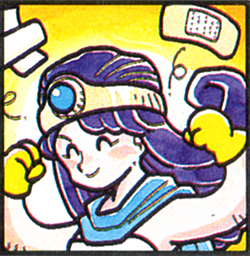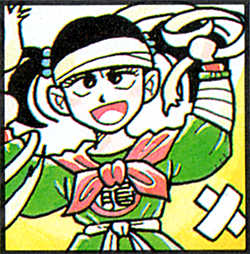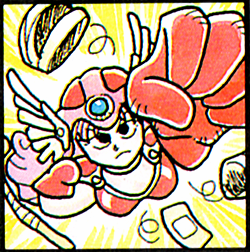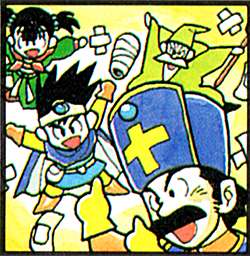DEALS ON HEALS: What should the next tier of healing magic cost?



Playing Dragon Warrior 3 recently, I found myself thinking once again about the MP costs of curative magic. In DW3 I learned three tiers of single-target healing spells: Heal, HealMore, and HealAll. Each tier restores more HP than the last, and because they all take the same length of time to enact (one turn), we can also say that the higher-tier spells are more “efficient” with respect to time: they heal more HP per turn. Each tier also costs more MP than the last. However, in proportion to the increase in power, the increase in MP cost is quite small, making HealMore a “better deal” than Heal, and HealAll a better deal than HealMore. We could say they’re more efficient with respect to MP cost: they heal more HP per MP spent. Higher-tier healing magic in DW3 is more turn-efficient and more MP-efficient than lower-tier healing magic.
Sometimes I've wondered: should higher-tier magic be more or less MP-efficient than lower-tier magic? I’ve encountered the complaint before that when a higher-tier spell is both more powerful and less expensive than a lower-tier one (all else being equal), the higher renders the lower obsolete, dismissing it from strategic consideration. If HealMore is stronger and a better deal than Heal, then why would I ever cast Heal again? By contrast, if higher-tier magic has worse MP-efficiency than lower-tier (say HealMore costs 3x as much MP as Heal but only restores 2x as much HP), then its increased power comes with a tradeoff. When I need HP urgently, I can pay a worse rate to cast HealMore and recover lots of HP now. When I have time to spare (like outside of battle), I can cast Heal multiple times to achieve the same degree of healing at a lower cost. In this way, multiple tiers of healing magic remain strategically relevant into the long term, because each is the best choice in different situations.
I’m sympathetic to this analysis. It's in sync with my experience of magic across different RPGs, and (all else being equal) I would rather have two healing options to continuously weigh than one foregone conclusion. What my time with Dragon Warrior 3 has suggested to me is that this understanding of MP-efficiency is not quite complete.
Much of the discussion about MP costs I've been privy to considers the efficiency of healing spells as if in a vacuum. In the abstract, we might say something like “HealMore restores 80 HP”, but in practice this isn't always the result the spell has. "HealMore restores 80 HP" is a statement of potential. When that potential can't be fully realized—when my target is missing less than 80 HP—the calculus of efficiency changes. These changes are palpable in a tense game like Dragon Warrior 3, where MP is scarce, traveling with an injured party is risky, and yet healing magic is very strong. I might want to heal when my HP is at 50%, but if I actually cast HealMore now, I won't gain as much HP for the cost as I will if I cast when my HP's at 25%. So the MP-efficiency of healing magic is in fact variable, and it tends to be better when my health is lower.
This dynamic occurs to some degree regardless of the relative efficiency of different tiers of magic. If my only source of healing is a Heal spell that restores 40 HP, I’ll generally want to wait until I’ve lost as close to 40+ HP as possible before healing in order to make my MP stretch as far as possible. This can be risky (especially if I only have 40 or so max HP in the first place!). If my strongest healing spell is also my most MP-efficient one, then I have a mathematical incentive to delay healing, potentially risking death (which is costly business in DW3) until my HP falls into the range where I can receive the full benefit of that spell for its fixed cost. The effect of additional tiers of increasingly strong and MP-efficient spells is to preserve this dynamic throughout the game. Because Heal, HealMore, and HealAll all restore most or all of a character's HP when I first learn them, I always have a healing spell available that incentivizes me to delay healing for as long as possible. I’m always making estimates about how low I can let my HP fall before healing—it's a pillar of risk management in Dragon Warrior 3.
By contrast, if higher-tier healing spells are less efficient, I don't waste MP by healing too soon, but by healing too late. If HealMore (as we imagined earlier) costs 3x as much as Heal but only restores 2x as much HP, it's cheaper to cast Heal twice instead of HealMore once, at the cost of an extra turn. Outside of battle where turns are "free", this is no issue. But when I need healing urgently and one turn's worth of Heal won't restore enough, I'm compelled to pay the higher price for the immediate relief of HealMore. The incentive now, for the sake of preserving MP, is to play cautiously and Heal proactively to help avoid winding up in a situation where I have to shell out for costly higher-tier magic. This "ounce of prevention" paradigm can be seen early in The 7th Saga for characters who learn HEAL1 and HEAL2 (at least before the Water Rune complicates the picture).
Herein lies my present answer to the question of whether MP-efficiency should increase or decrease with each tier. It depends on the nature of the game: increasing efficiency encourages bolder play and bigger risks, while decreasing efficiency rewards caution and risk avoidance. Which is “better” is kind of an aesthetic/thematic question. In Dragon Warrior 3, a game concerned with heroes as heroes, a mechanical incentive to take risks and endanger yourself makes a relevant statement about the nature of heroism. In this sense, increasing MP-efficiency feels a little more appropriate than it does in a game like 7th Saga, where my sense of stability is fragile even in the best circumstances. The decreasing MP-efficiency of healing spells helps sell low-HP combat situations as real emergencies, not only dangerous to be in but costly to escape - a picture of danger that reinforces the latent panic of the vast, deadly wastelands that make up 7th Saga's world. Either game could conceivably have functioned with the opposite relationship to healing magic efficiency, but the experiences of playing them might have taken on a different color.
Of course, these incentive systems can only be realized when MP conservation is a meaningful concern. For many RPGs in which MP is too abundant (or costs are too low) to impress a sense of precarity, healing becomes functionally free and unconstrained, reducing the range and weight of strategic questions pertaining to it. Different dynamics may materialize in their place, but the mechanisms of risk I’ve described depend on an environment of scarce MP, and so neither is found in games like Lufia 2 or Final Fantasy Tactics Advance, where the economical advantages of weaker healing spells completely evaporate.
As for the matter of increasing MP-efficiency rendering weaker spells obsolete, my time with Dragon Warrior 3 leaves me a little skeptical. Though it’s true that I almost completely stopped using HealMore once I had HealAll, I still often considered it when I wanted to heal for lesser amounts. Isn’t it conceivable that I might want to take the worse deal for immediate relief, or encounter a situation where I only needed to heal 80 HP? Even though I invariably chose to risk waiting for my HP to fall a little more so I could get the best rate from HealAll, the weaker spells still entered my thought process. I think I’ll need to have some more experiences before I can make a confident argument, so for now I’ll just remain open to the possibility, and also offer the thought that the decision to delay healing is probably just as meaningful as the decision between two healing spells. (And maybe even a little more interesting, as it’s a question of risk and intuition rather than selecting the best mathematical fit between two known quantities…)

For other stuff Dragon Warrior 3 made me think about, you can visit in this thread on Twitter.